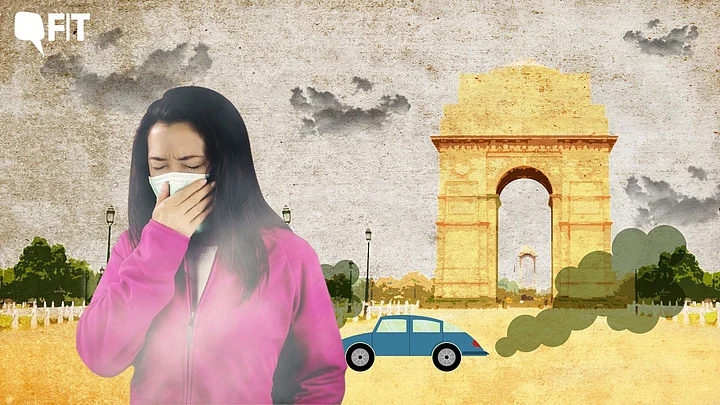"Delhi is so generous, it never sends back a visitor empty-handed. My uncle came here for cancer treatment, and he left with asthma."
"I saw the air pollution statistics and was stressed. Then I googled how to manage stress. The top suggestion was ‘take deep breaths’. IN DELHI??!"
"Shankar Mahadevan did a concert in Delhi. Every song was ‘Breathless’."
Air pollution is not a laughing matter... except when it is.
On Sunday, 10 March, as many as 20 comedians gathered in New Delhi’s Shri Ram Centre For Performing Arts and joked about air pollution, with Comicstaan Season 1 runner-up Rahul Dua hosting the lineup.
The event was aimed at raising awareness about the environmental and health hazards of air pollution.
In 2019, over 1,16,000 infants in India died due to air pollution within a month of being born, according to the State of Global Air report from 2020.
The same report put the total number of deaths in India due to air pollution at 1.67 million.
The need to talk about air pollution, clearly, is urgent and important. But are comedy shows the way to do so?
Does laughing about an issue take away from the seriousness of a problem that really does impact the lives and livelihoods of countless people every year?
Air Pollution Isn't Just a 'Delhi Problem'
Lest we forget, air pollution is a legitimate concern – one that is backed by statistics and our lived experiences alike.
But unlike the common narrative, Delhi is not the only problem city.
According to the 2020 World Air Quality Report, released by IQAir, as many as 22 Indian cities featured in the list of the top 30 most polluted cities globally.
This list included names like Ghaziabad, Bulandshahar, Noida, Kanpur, Lucknow, Bhiwadi, Faridabad, Gurugram, Muzaffarpur, among others.
In October 2023, the Bombay High Court was forced to take suo moto cognisance of Mumbai’s deteriorating air quality as it was impacting the health of citizens.
On 23 October last year, the PM 2.5 levels in Mumbai were at a record 75 μg/m3, which was five times the World Health Organisation’s limit.
A recent report released by the Brihanmumbai Municipal Corporation (BMC) said that construction, climate change, and burning of solid waste were among the top reasons for air pollution in the city.
As we pointed, the concern is legitimate and demands our attention. But is enough being done about it?
According to 2021 data from the Council On Energy, Environment And Water (CEEW), India only has only 804 manual and 286 real-time air quality monitoring stations.
This means only close to 0.8 monitors per million people.
The CEEW report also added that most of these monitoring stations are concentrated in urban India, with rural India only having 26 manual stations.
Fresh Messaging is Needed to Drive the Point in
When the concern is this big, how do you make people care about it?
Especially when even stakeholders like the news media also only care about it from November to February, when air pollution is at its peak and noticeably starts affecting all walks of life.
Over the years, people have taken different approaches to talk about air pollution.
In February 2020, an environment advocacy group called Greenpeace India organised a flash mob at multiple places in Delhi to draw people’s attention towards the importance of clean air.
Last year in November, school children rallied around West Delhi, holding up drawings and posters about air pollution, under an initiative taken by NGO CHETNA.
School and college students in Delhi have also, on multiple occasions, participated in Nukkad Nataks (or street theatre) to raise awareness about air pollution.
Brikesh Singh, Convenor of Clean Air Collective and Chief of Communications and Engagement at Asar, who was one of the organisers of the comedy event on Sunday, speaking to The Quint, points that fresher perspectives are needed to talk about causes that are important.
“Using comedy to tackle a serious problem like air pollution is not without its challenges. I believe that there is a fine line between humour and trivialisation as it directly impacts people and their life.”Brikesh Singh
'Make the Conversation More People-Centric'
Speaking to The Quint for an earlier story, Abinash Mohanty, Sector Head, Climate Change & Sustainability at IPE Global, and Expert Reviewer of IPCC- AR(6), had also said that there’s an urgent need to make climate change and climate science more people-centric and more palatable to the masses.
He added, “Our conversations around climate change need to become people-centric, less jargonised, and more in tune with the climate-proofing of lives and livelihoods.”
“When there’s rainfall, will I be inundated knee deep or will only an inch of my car be under water? Is my house budget going to increase when there’s a heatwave? These are some of the questions that need to be answered through attributional science practitioners. This will cast the stone for making it people-centric in the true sense.”Abinash Mohanty
Singh agrees with this. For him, the main intent of raising awareness is reaching people who are impacted by pollution but might not know how to tackle it.
“Not diversifying how we are communicating this important topic will also mean that we continue talking to echo chambers. Comics have the power to cut through the jargon and force people to see the truth,” says Singh.
